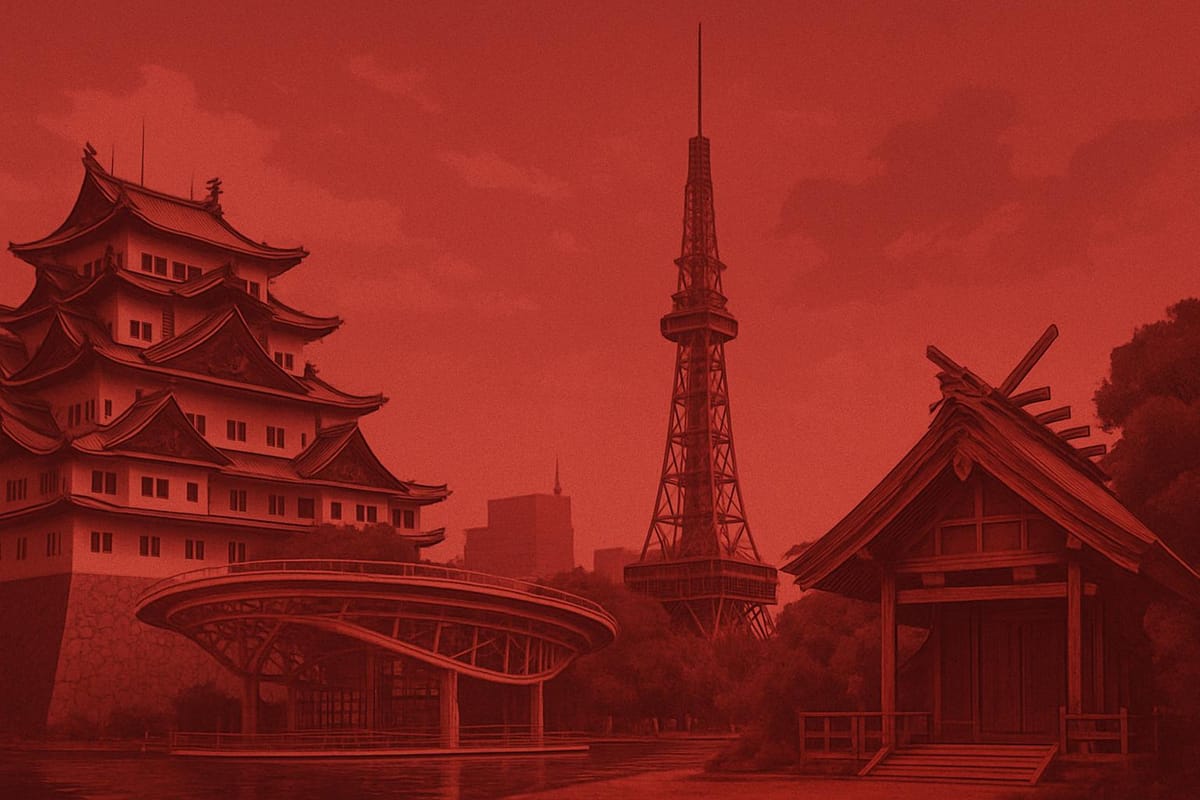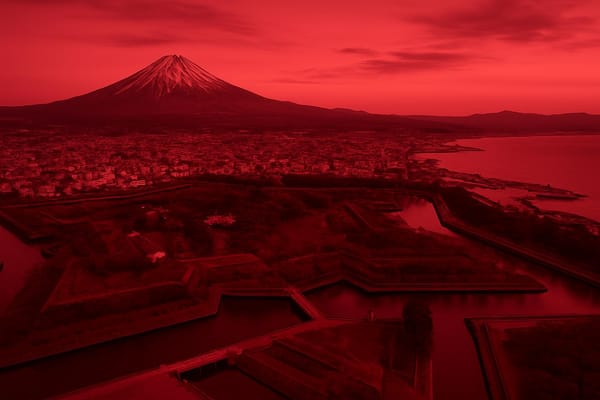Nagoya
Discover a historic castle, vibrant food scene, cutting-edge museums and top shopping districts.

Important things to know about Nagoya
Nagoya, Japan is a dynamic urban center where modern industry and everyday life blend into a distinctive metropolitan character, and the city’s identity as an industrial powerhouse is evident in its role within the Chūbu region’s manufacturing network, especially in automotive and aerospace sectors; beyond factories and corporate campuses, Nagoya offers a multifaceted urban lifestyle with dense residential neighborhoods, lively commercial districts, efficient public transportation, and a rhythm shaped by commuters, students, and a diverse workforce, making Nagoya a compelling study in urban planning and economic resilience. The climate brings hot, humid summers and mild winters that influence seasonal festivals and local routines, while the population’s pragmatic approach fosters a strong sense of community cohesion and neighborhood-level engagement, from small family-run enterprises to cutting-edge startups. Education and research institutions contribute to a culture of innovation, and the city’s culinary identity - famous for hearty, savory flavors and local specialities found in everyday eateries and markets - reflects both long-standing traditions and contemporary tastes without relying on tourist-oriented portrayals. Infrastructure investments, including rail, road, and logistics, reinforce Nagoya’s position as a national transport hub, supporting commerce and daily mobility; meanwhile, cultural life, public spaces, and municipal services emphasize quality of life and sustainability initiatives that appeal to residents and businesses alike. Whether considered for business, study, or longer-term living, Nagoya, Japan presents a balanced urban environment where economic vigor, community values, and practical modernity converge into a uniquely Japanese metropolis.
Sightseeing hot-spots in Nagoya
Nagoya is a vibrant hub of culture and modernity where sightseeing offers a mix of samurai history and cutting-edge industry. A top attraction is Nagoya Castle, famous for its reconstructed keep and the iconic golden shachihoko dolphins that glint atop the roof; the surrounding gardens and on-site museum provide deep insight into the feudal era. For museum lovers, the Toyota Commemorative Museum of Industry and Technology and the SCMAGLEV and Railway Park showcase Japan’s engineering prowess, making Nagoya a compelling destination for travelers seeking both tradition and innovation.
The city’s spiritual and shopping life is equally enticing, with Atsuta Shrine-one of Japan’s most revered Shinto sites-offering tranquil grounds and cultural ceremonies. Nearby, the lively Osu Kannon area mixes historic temples with the eclectic Osu Shopping District, where narrow streets are lined with vintage shops, anime stores and street food stalls. The energetic Sakae district is perfect for nightlife and panoramic city views from landmarks like Nagoya TV Tower, while family-friendly outings include the impressive Nagoya Port Aquarium and waterfront attractions that appeal to all ages.
No visit to Nagoya is complete without sampling local cuisine and experiencing the city’s excellent transport links. Food highlights such as hitsumabushi (grilled eel over rice) and miso katsu reflect the region’s unique flavors and make dining an essential part of sightseeing. With major hubs like Nagoya Station providing easy access to bullet trains and local transit, planning things to do in Nagoya is straightforward, allowing travelers to maximize time exploring historic sites, modern museums, shopping districts and culinary delights.
Hotels to enjoy in Nagoya
Nagoya is a dynamic gateway to central Japan and the selection of Nagoya hotels reflects that variety, catering to both business and leisure travelers. From sleek high-rise properties near Nagoya Station to stylish boutique stays in Sakae, visitors can find accommodation that combines modern comforts with easy access to public transport, shopping, and dining. Many hotels emphasize convenient location and practical amenities-fast Wi-Fi, meeting rooms, and shuttle services-making them ideal for business travel or quick city breaks. Whether you are arriving to attend a conference at the Nagoya convention centers, exploring local cuisine like hitsumabushi, or planning day trips to nearby attractions, staying in a centrally located hotel simplifies logistics and maximizes sightseeing time.
For travelers seeking variety, the range of hotels in Nagoya spans luxury international brands offering rooftop bars and full-service spas to budget-friendly business hotels and unique capsule options that appeal to solo visitors and short-stay tourists. Traditional experiences are available too, with select ryokan-style accommodations and properties that feature onsen-like baths for relaxation after visiting Nagoya Castle or Atsuta Shrine. When choosing Nagoya accommodation, consider proximity to subway lines and JR connections for easy access to attractions such as Osu Kannon and the SCMaglev and Railway Park. Booking tips include checking cancellation policies, seasonal rates around festival times, and combining location with core amenities to find the perfect balance of comfort, price, and local character for your Nagoya trip.
Restaurants to try in Nagoya
Nagoya's restaurants offer a rich tapestry of flavors that reflect the city's unique culinary history and vibrant dining scene. From traditional oden and cozy izakaya tucked into alleyways near Osu to upscale sushi bars and Michelin-starred venues in Sakae, visitors will find a range of options that satisfy any palate. Local specialties define much of the city's appeal: hitsumabushi (grilled eel over rice) delights with layers of smoky, savory complexity, while miso katsu - a deep-fried pork cutlet topped with rich red miso sauce - showcases the region's signature use of red miso. Noodle lovers will want to try kishimen, flat udon-style noodles served in light broth, and those seeking late-night eats will discover bustling izakaya culture where small plates encourage sharing and socializing. The concentration of restaurants in central Nagoya makes it easy to plan a culinary crawl through historical neighborhoods and modern shopping districts alike.
For food-focused travelers and locals exploring Nagoya's restaurant offerings, attention to seasonal ingredients and craft techniques elevates even simple dishes into memorable experiences. Many Nagoya restaurants pride themselves on sourcing local produce, seafood from Ise Bay, and artisanal miso from nearby towns, which helps create a distinct Nagoya-style flavor profile that food writers and bloggers often recommend. Whether you are hunting for the best restaurants in Nagoya, seeking authentic regional cuisine, or planning a gastronomic itinerary, the city's food scene provides both comfort and innovation-perfect for those who want to taste the heart of central Japan through carefully prepared, flavorful meals and warm hospitality.
Best shopping stops in Nagoya
Nagoya is a vibrant destination for shopping in Nagoya, where modern retail hubs and historic lanes sit side by side. The bright, bustling district of Sakae offers flagship stores, fashion boutiques and the iconic Sunshine Sakae complex, while the area around Nagoya Station is home to massive department stores and expansive underground malls filled with electronics, cosmetics and seasonal goods. For trend-seeking visitors, the retro-meets-modern atmosphere of Osu Shopping Street and Osu Kannon’s nearby lanes deliver vintage clothing, quirky accessories and pop-culture finds, making it one of the top shopping highlights in the city. Shoppers looking for convenience will appreciate the seamless connectivity between train stations and shopping centers, allowing a full day of exploration without straying far from transport hubs.
Beyond big brands and bustling arcades, Nagoya’s charm shines through its food halls and local crafts. The famous depachika (department store basements) tempt with gourmet bites, regional sweets and packaged miso products that make authentic souvenirs for friends and family. Traditional artisans in and around the city produce Arimatsu shibori textiles, lacquerware and ceramics that reflect centuries-old techniques - ideal keepsakes for those seeking something uniquely Japanese. Whether hunting for the latest gadgets near Nagoya Station, discovering indie designers in Sakae, or sampling handcrafted goods and specialty foods in Osu, shopping highlights of Nagoya deliver a blend of quality, variety and local flavor that rewards both casual browsers and dedicated shoppers.
Nightlife highlights in Nagoya
Nagoya nightlife pulses with energy after sunset, offering a diverse mix of entertainment that draws both locals and visitors across Japan. In the neon-lit districts of Sakae and Osu you’ll find a fusion of buzzing izakayas, modern clubs, and cozy Nagoya bars where craft cocktails and regional specialties are served late into the night. Music lovers can hunt down intimate live music venues and hidden jazz bars that host talented local acts, while groups of friends head to private karaoke rooms to sing until the early hours. The area around Nagoya Station and Fushimi also boasts rooftop lounges and stylish speakeasies, creating a nightlife scene that balances traditional Japanese hospitality with contemporary nightlife trends.
For a perfect Nagoya night out, pair a crawl through bustling alleyway izakayas with a stop at a craft beer taproom or a stylish club pulsing with DJ sets; food options range from late-night ramen to skewers grilled at yakitori joints, so you can sample local flavors at every turn. Whether you’re into dancing, discovering underground live houses, or savoring quiet cocktails in a rooftop bar, Nagoya nightlife offers varied experiences that make the city an exciting after-dark destination in Japan.
Getting around in Nagoya
Nagoya’s airport situation centers on Chubu Centrair International Airport, a modern gateway offering efficient airport access to the city via the Meitetsu μ-SKY limited express, airport buses and taxis, making downtown Nagoya reachable in about 28–40 minutes depending on mode, while the city’s train network is anchored at Nagoya Station, a major hub on the JR Tokaido Shinkansen line that provides fast links to Tokyo, Kyoto and Osaka; local travel is well served by JR Central lines, Meitetsu and Kintetsu railways plus the extensive Nagoya Municipal Subway, all integrated with rechargeable IC cards like Manaca/TOICA for seamless transfers, and frequent services help travelers and commuters move efficiently across business districts, shopping areas and cultural sites. For visitors, this combination of airport connectivity and high-frequency trains means straightforward transfers for long-distance travelers arriving on international flights, convenient day trips using the Shinkansen, and dependable urban mobility-making Nagoya’s transport ecosystem both practical for daily commuters and attractive for tourists seeking quick, reliable links between Chubu Centrair, Nagoya Station, and the wider Kansai–Kanto corridor.
Culture must-see's in Nagoya
Nagoya, Japan is a vibrant center of traditional and contemporary culture, where samurai history blends with modern city life. Visitors are drawn to iconic sites such as Nagoya Castle, whose restored towers and golden shachihoko symbolize the city’s feudal past, and Atsuta Shrine, revered for its ancient Shinto rituals and seasonal festivals. The museum scene - from the Tokugawa Art Museum showcasing samurai treasures to the SCMAGLEV and Railway Park highlighting engineering heritage - offers deep dives into regional identity. Strolling through neighborhoods like Sakae and Osu, you encounter a mix of boutique craft shops, anime-inspired stores, and intimate tea houses hosting the tea ceremony, reflecting Japan’s enduring aesthetic of hospitality and attention to detail.
Culinary culture is equally central to Nagoya’s appeal, with specialties like miso-katsu, hitsumabushi and kishimen defining the flavor profile of central Japan. Local festivals and performing arts present opportunities to see traditional music, kabuki-style theater, and community parades that animate streets year-round, while craft workshops teach pottery, lacquerware and textile techniques rooted in centuries-old practices. For travelers seeking authentic cultural experiences in Nagoya, Japan, combining historic landmarks, culinary exploration, and hands-on artisan activities creates a rich itinerary that highlights both the distinctive local character and broader Japanese traditions.
History of Nagoya
Nagoya's recorded story begins long before it became a modern metropolis; the city's roots lie in ancient settlements of what is now Aichi Prefecture, evolving through the medieval period as a strategic and cultural crossroads. The foundation of Nagoya as a political center crystallized in the early 17th century with the construction of Nagoya Castle, commissioned by the Tokugawa shogunate to secure the Tōkaidō route and assert control over the prosperous Owari domain. Under the Tokugawa family’s Owari branch, Nagoya flourished as a hub of samurai administration, merchant activity, and artisan craft, producing distinctive ceramics, textiles, and lacquerware. The Edo period established many of the city's cultural institutions and urban patterns-market streets, temple precincts, and guild-based industries-that would influence Nagoya’s later growth. Throughout this era, the city balanced its military importance with a rising commercial identity, planting seeds for the industrial transformation that followed the Meiji Restoration.
The modern era accelerated Nagoya’s transformation into one of Japan’s leading economic engines. After the Meiji period opened the country to rapid industrialization, Nagoya became a center for heavy industry, manufacturing and transport, aided by expanding railways and port facilities. The 20th century brought both devastation and renewal: extensive damage during World War II required major postwar reconstruction, which in turn set the stage for rapid economic growth and urban redevelopment. Nagoya’s proximity to Toyota’s founding region and its evolving cluster of automotive, aerospace, and ceramic industries solidified its reputation as an industrial powerhouse. Cultural recovery and civic pride accompanied economic success, visible in institutions like Atsuta Shrine, innovative museums, and events such as the Nagoya Festival and the internationally recognized Aichi Expo 2005. Today, the history of Nagoya blends samurai-era heritage, industrial might, and contemporary culture-making Nagoya, Japan, a compelling destination for visitors interested in both historical depth and modern urban dynamism.



